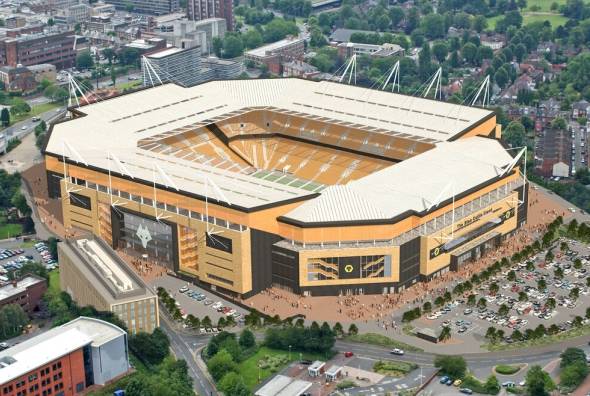It's been several years now since Wolverhampton Wanderers announced a plan to expand their Molineux stadium. Back in 2019, the club revealed that they were looking into the possibility of increasing the capacity at their home to the 50,000 mark.
The club's promotion to the Premier League in 2018 was said to be the catalyst for these plans, but six years after they were first announced, the club are no further along with their renovation. Why? Here is everything you need to know.
Covid pandemic sees Molineux Stadium expansion shelved
The plans released in 2019 stated that the Steve Bull Stand would be the first stand to be expanded. The plan was for extensive corporate facilities and an initial increase in the capacity of Molineux to around 36,000.
The second phase of the development was going to see the Jack Hayward (South Bank) Stand being replaced at one end with a much larger single-tiered stand of around 10,000 as well as the corners of the stadium being filled in with seats.
However, when Covid struck in 2020, these plans were plunged into doubt. The empty stands throughout the pandemic affected cash flow and forced the Wolves owners to reassess their priorities.
Ultimately, instead of the planned rebuild, they opted to splash the cash on the playing squad in order to remain competitive in the Premier League.

Molineux Stadium capacity
The original expansion plans were ambitious in that they wanted to increase the stadium's capacity to the 50,000 mark. That would represent a significant increase on the current capacity of 31,500.
If the plans ever come back to life, then at 50,000, the stadium would become the largest football stadium in the Midlands and one of the biggest in the Premier League. At present, Villa Park is the largest stadium in the Midlands, with a capacity of 42,573, but that will soon move past the 50,000 mark due to renovation work on the North Stand.
The threat of relegation looms large
Whether Wolves would be able to sell out a stadium of that size regularly is another question altogether. Throughout the 2024/25 season, they averaged 30,635 fans at Molineux, which is 97% of their overall capacity. This suggests they do have the fan power to justify a move, but would that be the case if they suffered relegation?
Wolves have flirted with the drop zone for a couple of seasons now, and only avoided the drop last term following their resurgence under Vitor Pereira. However, the Portuguese coach lost key players like Matheus Cunha and Rayan Ait-Nouri in the summer, and then was sacked in November 2025 following a disappointing start to the season.
Rob Edwards has since taken over the reins, but Wolves are already looking like a team heading to the Championship. As a result, the club will be wary that they averaged around 21,000 fans a game at Molineux during their last stint outside the top flight from 2012 and 2018. This is around 66% of the overall capacity at Molineux and would be less than half in a 50-000-seater stadium.
As a result, they will be reluctant to work on their stadium without being confident about their chances of remaining in the Premier League for the long term. As per BBC Sport, they are also likely to spend any available funds on the squad rather than on stadium development.
What has the owner said about the plans
It is quite telling that we have heard nothing from the Wolves hierarchy about these plans for four years now. The latest update from the club Chairman, Jeff Shi, came in the summer of 2025. He said in an interview with the Business of Sport podcast:
“Molineux is not a bad stadium. I have been to many stadiums in the UK, and it’s a good stadium.
“On capacity, we have 32,000, and I think it’s good enough, maybe 35k or 40k is the max for the city, but it’s not urgent. The urgent changes are that I think we should have more hospitality areas to serve the clients who want a better environment to have a conference or to eat there. We should do more on this.
“We have a very old stand, the Steve Bull stand, it's too old. The next plan is to try and change a bit there and build more areas for hospitality, similar to what Fulham did with their new stand. That's what we are trying to do, but I don't think the capacity should be much higher than it is now.
Cost could be a prohibitive factor
It's thought that the stadium renovations would cost around £30 million, but the investment would at least preserve the club's history and place in Wolverhampton City Centre as opposed to building a new, out-of-town ground.
However, the modern era of Premier League football is governed by profit and sustainability rules – nobody wants to see their club run as a business, but it is virtually a necessity nowadays.
Officials and board members at Wolves will be looking at the financial strain Everton's new stadium has placed on the club, which was a huge factor in the Toffees' various points deductions.
That is not to say that cost and finances will prohibit the Molineux from ever being expanded, but it is a good sign, albeit a frustrating one, for fans of the club that Wolves appear to be handling the situation responsibly.
How an expanded Molineux could look

The artist's impression above is shown courtesy of the Wolverhampton Wanderers FC website from 2019.
